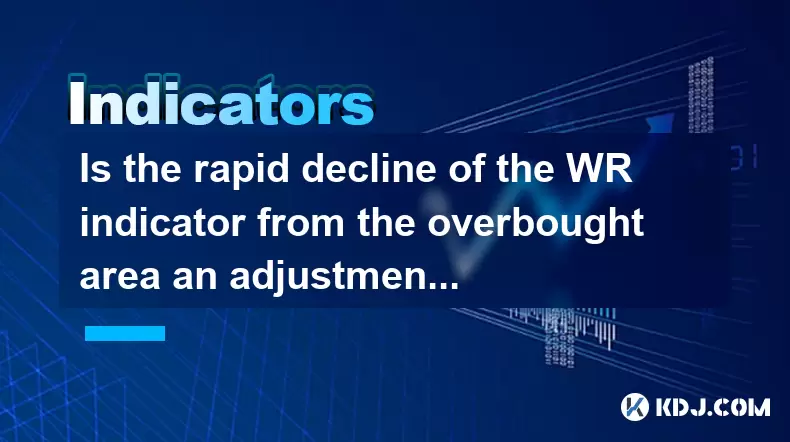-
 bitcoin
bitcoin $109523.663807 USD
-0.13% -
 ethereum
ethereum $4019.526508 USD
2.06% -
 tether
tether $1.000482 USD
0.00% -
 xrp
xrp $2.776815 USD
0.18% -
 bnb
bnb $958.942396 USD
0.12% -
 solana
solana $204.294698 USD
3.84% -
 usd-coin
usd-coin $0.999693 USD
0.00% -
 dogecoin
dogecoin $0.232115 USD
2.09% -
 tron
tron $0.338028 USD
0.84% -
 cardano
cardano $0.790920 USD
1.50% -
 hyperliquid
hyperliquid $44.871443 USD
5.60% -
 ethena-usde
ethena-usde $1.000322 USD
0.04% -
 chainlink
chainlink $21.034165 USD
2.60% -
 avalanche
avalanche $28.794831 USD
-0.54% -
 stellar
stellar $0.360466 USD
1.24%
Is the rapid decline of the WR indicator from the overbought area an adjustment signal?
A sharp drop in Williams %R from overbought levels can signal weakening momentum and potential bearish reversals, especially when confirmed by price action and volume.
Jun 14, 2025 at 10:15 pm

Understanding the WR Indicator and Its Significance
The Williams %R (WR) indicator is a momentum oscillator used in technical analysis to identify overbought or oversold conditions in a market. It ranges from 0 to -100, with readings above -20 considered overbought and below -80 considered oversold. Traders often use this tool to predict potential reversals based on extreme levels. When WR rapidly declines from the overbought area, it can signal a shift in market sentiment.
This sudden drop suggests that selling pressure may be increasing after a period of strong buying activity. The key here lies in interpreting the speed and context of the decline. A sharp move downward from overbought territory could indicate that bulls are losing control and bears are starting to take over.
How to Identify a Rapid WR Decline
To determine whether a WR decline is 'rapid,' traders should look at both the time frame and the magnitude of the movement. A rapid decline typically occurs when the WR moves from above -20 to below -50 within just a few candlesticks. This kind of drop implies urgency and strength in the selling momentum.
- Check the current value of WR to ensure it was recently in the overbought zone.
- Observe the rate at which the WR line falls — a steep slope indicates a rapid decline.
- Cross-reference with price action to confirm if the underlying asset is also showing signs of weakness.
This pattern is especially significant when it aligns with other bearish signals such as bearish candlestick patterns or resistance levels being tested.
Is a Rapid WR Drop Always an Adjustment Signal?
Not every sharp WR drop from the overbought region leads to a meaningful price correction. In some cases, especially during strong uptrends, the WR can dip quickly and then rebound without triggering a substantial reversal. Therefore, context is crucial.
- If the price remains above a key moving average while the WR dips, the decline might just be a temporary pullback.
- Volume plays a role — a spike in selling volume alongside the WR drop strengthens the adjustment signal.
- Market structure matters — if the price is approaching a major support level, the decline may not lead to a full reversal.
Traders should avoid making decisions solely based on WR movements without confirming through other indicators or chart patterns.
Combining WR with Other Indicators for Confirmation
To increase the reliability of the WR signal, it’s wise to combine it with other tools:
- Moving Averages: If the price crosses below a key moving average like the 50-period SMA during a WR drop, it reinforces the bearish signal.
- RSI: If RSI also shows bearish divergence or enters the neutral zone (around 50), it supports the idea of weakening momentum.
- MACD: A bearish MACD crossover at the same time as the WR decline can provide additional confirmation.
These combinations help filter out false signals and give traders more confidence in their decision-making process.
Practical Steps to Trade Based on WR Decline Signals
If you're considering entering a trade based on a WR drop from overbought territory, follow these steps carefully:
- Monitor the WR indicator closely once it reaches above -20.
- Wait for the WR to fall sharply — ideally crossing below -50 within a short time frame.
- Confirm with price action — look for bearish candles or rejection at resistance.
- Check volume — increased volume during the WR drop adds credibility to the signal.
- Enter a short position only after confirming with at least one other indicator.
- Set a stop-loss slightly above the recent swing high to manage risk.
- Consider taking partial profits as the price approaches key support levels.
It's essential to maintain discipline and not rush into trades based on isolated WR signals. Patience and confirmation are key to successful trading using this method.
Common Pitfalls to Avoid
Many traders misinterpret WR signals due to common mistakes:
- Assuming that any WR drop from overbought territory is a sell signal without checking other factors.
- Ignoring trend direction — trading against the trend based solely on WR can be risky.
- Failing to adjust for volatility — in highly volatile markets, WR can give exaggerated signals.
- Not using stop-loss orders — even valid signals can fail, so risk management is critical.
Avoiding these pitfalls ensures that traders don't act impulsively and instead make informed decisions based on multiple data points.
Frequently Asked Questions
Q: Can the WR indicator be used effectively on all time frames?A: While WR can be applied to any time frame, its effectiveness varies. Shorter time frames like 15-minute or 1-hour charts may generate more frequent but less reliable signals. Daily and weekly charts tend to produce clearer and more actionable setups.
Q: What is the difference between WR and RSI in identifying overbought conditions?A: Both indicators measure momentum, but they do so differently. RSI uses a smoothed calculation and has a scale from 0 to 100, while WR is a raw oscillator ranging from 0 to -100. WR tends to react more quickly to price changes, making it more sensitive than RSI.
Q: Should I always wait for WR to reach exactly -20 before considering an overbought condition?A: No. Some traders adjust the threshold based on market conditions or assets. For example, in trending markets, higher thresholds (like -10) may be used to define overbought levels. Flexibility and adaptation are important.
Q: How does WR behave in sideways or ranging markets compared to trending ones?A: In ranging markets, WR tends to oscillate predictably between overbought and oversold levels, offering clearer signals. In trending environments, WR can remain in overbought or oversold zones for extended periods, leading to misleading signals if not interpreted carefully.
Disclaimer:info@kdj.com
The information provided is not trading advice. kdj.com does not assume any responsibility for any investments made based on the information provided in this article. Cryptocurrencies are highly volatile and it is highly recommended that you invest with caution after thorough research!
If you believe that the content used on this website infringes your copyright, please contact us immediately (info@kdj.com) and we will delete it promptly.
- BlockchainFX: The Crypto Presale Primed for a 2025 ROI Explosion
- 2025-09-27 18:25:19
- ETH Price Check: Smart Money Stays Cool Amidst ATH Rollercoaster
- 2025-09-27 18:25:19
- Whale Watch: Lyno AI Presale Gains Momentum with AI-Powered Arbitrage
- 2025-09-27 18:30:01
- Token Migration Mania: TTM Unification and Resource Tokens on the Move!
- 2025-09-27 18:30:01
- Pi Network, Remittix, and Crypto News: Navigating the Shifting Sands of Altcoins
- 2025-09-27 18:30:01
- King Charles 50p Coin: Is Your Pocket Change Worth a Fortune?
- 2025-09-27 18:30:13
Related knowledge

What is a tower bottom candlestick pattern? Does it have a high success rate?
Sep 22,2025 at 07:18am
Tower Bottom Candlestick Pattern Explained1. The tower bottom candlestick pattern is a reversal formation that typically appears at the end of a downt...

What is a black hole pattern in the MACD indicator? Is it a cause for concern?
Sep 21,2025 at 06:54pm
Bitcoin's Role in Decentralized Finance1. Bitcoin remains the cornerstone of decentralized finance, serving as a benchmark for value and security acro...

How can I use the psychological line (PSY) to determine market sentiment?
Sep 17,2025 at 02:19pm
Understanding the Psychological Line (PSY) in Cryptocurrency TradingThe Psychological Line, commonly referred to as PSY, is a momentum oscillator used...

How can I determine if a double top pattern has officially formed?
Sep 21,2025 at 03:18am
Understanding the Structure of a Double Top Pattern1. A double top pattern consists of two distinct peaks that reach approximately the same price leve...

What is the Golden Valley pattern on the moving average? Is it better than the Silver Valley pattern?
Sep 21,2025 at 02:54pm
Understanding the Golden Valley Pattern in Moving Averages1. The Golden Valley pattern is a technical formation observed in cryptocurrency price chart...

What does a death cross of the RSI in the strong zone (above 50) mean?
Sep 17,2025 at 10:54pm
Understanding the Death Cross in RSI Context1. The term 'death cross' is traditionally associated with moving averages, where a short-term average cro...

What is a tower bottom candlestick pattern? Does it have a high success rate?
Sep 22,2025 at 07:18am
Tower Bottom Candlestick Pattern Explained1. The tower bottom candlestick pattern is a reversal formation that typically appears at the end of a downt...

What is a black hole pattern in the MACD indicator? Is it a cause for concern?
Sep 21,2025 at 06:54pm
Bitcoin's Role in Decentralized Finance1. Bitcoin remains the cornerstone of decentralized finance, serving as a benchmark for value and security acro...

How can I use the psychological line (PSY) to determine market sentiment?
Sep 17,2025 at 02:19pm
Understanding the Psychological Line (PSY) in Cryptocurrency TradingThe Psychological Line, commonly referred to as PSY, is a momentum oscillator used...

How can I determine if a double top pattern has officially formed?
Sep 21,2025 at 03:18am
Understanding the Structure of a Double Top Pattern1. A double top pattern consists of two distinct peaks that reach approximately the same price leve...

What is the Golden Valley pattern on the moving average? Is it better than the Silver Valley pattern?
Sep 21,2025 at 02:54pm
Understanding the Golden Valley Pattern in Moving Averages1. The Golden Valley pattern is a technical formation observed in cryptocurrency price chart...

What does a death cross of the RSI in the strong zone (above 50) mean?
Sep 17,2025 at 10:54pm
Understanding the Death Cross in RSI Context1. The term 'death cross' is traditionally associated with moving averages, where a short-term average cro...
See all articles









































































